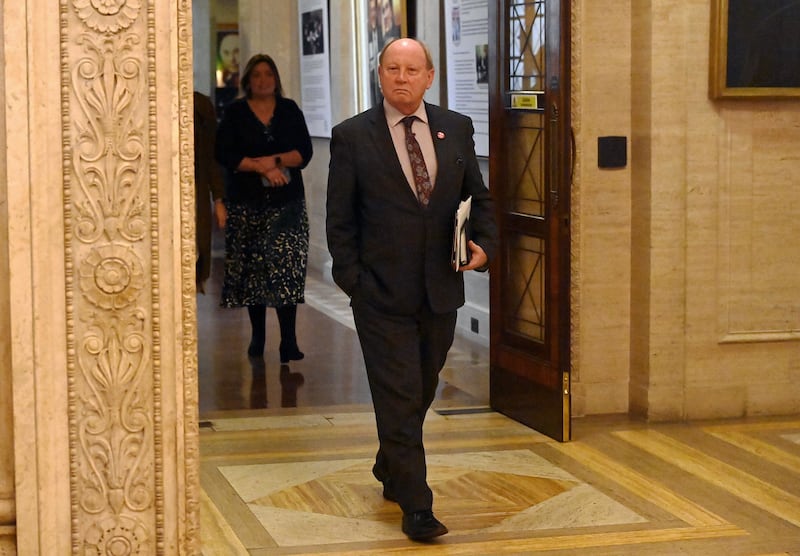As she rose to speak just before 2:30pm, Michelle O’Neill glanced briefly up at the public viewing gallery high on the other side of Stormont’s grand debating chamber.
There, watching her, were her grown up daughter and son, Saoirse and Ryan. Seated close to them were Sinn Fein leader Mary Lou McDonald and senior TD Pearse Doherty.
Also there was former Sinn Fein president Gerry Adams and Fiachra McGuinness, the son of Martin McGuinness, often cited as Ms O’Neill’s political mentor.
The political symbolism of the moment was clear, generations of republicanism coming together to welcome Northern Ireland’s first nationalist first minister taking up office.
The new First Minister @moneillsf making her first speech in the Assembly Chamber. pic.twitter.com/O8U67tIVsW
— Northern Ireland Assembly (@niassembly) February 3, 2024
Around an hour before, Ms O’Neill had been applauded by supporters as she walked alone down the staircase which leads to Stormont’s Great Hall, on her way to her moment of history.
When she spoke, her message reflected the journey she has been on – and also reached out to her political opponents.
She said: “As an Irish republican I pledge co-operation and genuine honest effort with those colleagues who are British, of a unionist tradition and who cherish the union.
“This is an Assembly for all – Catholic, Protestant and dissenter.
“Despite our different outlooks and views on the future constitutional position, the public rightly demands that we co-operate, deliver and work together.”
“This is a historic day which represents a new dawn,” she said.
“For the first time ever, a nationalist takes up the position of first minister.
“That such a day would ever come would have been unimaginable to my parents and grandparents’ generation.”
The new deputy First Minister @little_pengelly makes her first speech in the Assembly Chamber. pic.twitter.com/LyhUdCBYZm
— Northern Ireland Assembly (@niassembly) February 3, 2024

Next to speak was Emma Little-Pengelly, the DUP’s nomination to serve as deputy first minister.
While her speech also reflected her own political journey, referring to “growing up in conflict”, she also reached out across the political divide.
She said: “The past with all its horror can never be forgotten, and nor will it be allowed to be rewritten but while we are shaped by the past, we are not defined by it.
“The experience of my childhood gave me the drive and desire to make a different future not just for myself, but to do all that I could and can to ensure a better future for all of us.
“Across this chamber we have different political viewpoints and experiences, but what we also know is that the mummy waiting on her cancer diagnosis is not defined as being republican or unionist.”
While reconciliation and co-operation were the themes of the first full sitting of the Northern Ireland in two years, it was not without bitter exchanges.

TUV leader Jim Allister, a vocal critic of the DUP’s deal with the Government which has restored the powersharing institutions, said it was a day of “gloating and glee” for republicanism.
He also accused the DUP, Northern Ireland’s largest unionist party of a “climbdown of monumental proportions”.
In response, DUP MLA Paul Givan branded Mr Allister a “political failure” and a “dead-end unionist”.
It was perhaps fitting that Mr Givan spoke, as it was two years to the day that his resignation as first minister as a protest over post-Brexit trading arrangements collapsed the powersharing executive and put the Assembly into cold storage.
Mr Givan said it had been a “long road” to get back.
There was humour in the chamber too when Sinn Fein MLA Gerry Kelly, a former IRA prisoner, mistakenly nominated a colleague for the position of “deputy chief constable” rather than deputy speaker.

MLAs had begun to file into the chamber well in advance of the 1pm start for the sitting. Cara Hunter, Daniel McCrossan and Patsy McGlone were first to arrive, taking a moment to locate their seats before they posed together for selfies.
A series of ministers were nominated to lead Stormont departments, using the D’Hondt mechanism which measures party strengths.
There was a strong sense of choreography to the proceedings, which was interrupted when the DUP unexpectedly took the education portfolio as its first pick, rather than finance, as has been widely expected.
Sinn Fein quickly asked for an adjournment, and DUP leader Sir Jeffrey Donaldson and his deputy Gavin Robinson were shortly after seen hurrying in the direction of Ms O’Neill’s new First Minister office.
In truth, Stormont had not seen a day like it in decades, with the massive media interest seeming to catch officials by surprise.
By the time the front doors were opened at 9am, there was already a queue of camera crews eager to get the best spots.
A small section which had been roped off for journalists quickly filled, swelled and burst its banks as the media took over most of the wide open space in the capacious Great Hall.

At one point Northern Ireland Secretary Chris Heaton-Harris could be seen high on the gallery above taking photographs of the huge press pack on his mobile phone.
The contrast with the last two years could not have been clearer. On most days since the previous Assembly collapsed, the hall, the chamber, the maze of corridors, have been close to empty, apart from tourists being taken on guided tours.
On this day the corridors were filled with Stormont officials and journalists, many of whom were on a quest to find the famous old building’s well-hidden canteen.
Thankfully, as the day dragged on, Northern Ireland’s new agriculture minister, Andrew Muir, was on hand to give out sweets to the gaggle of hungry journalists.







